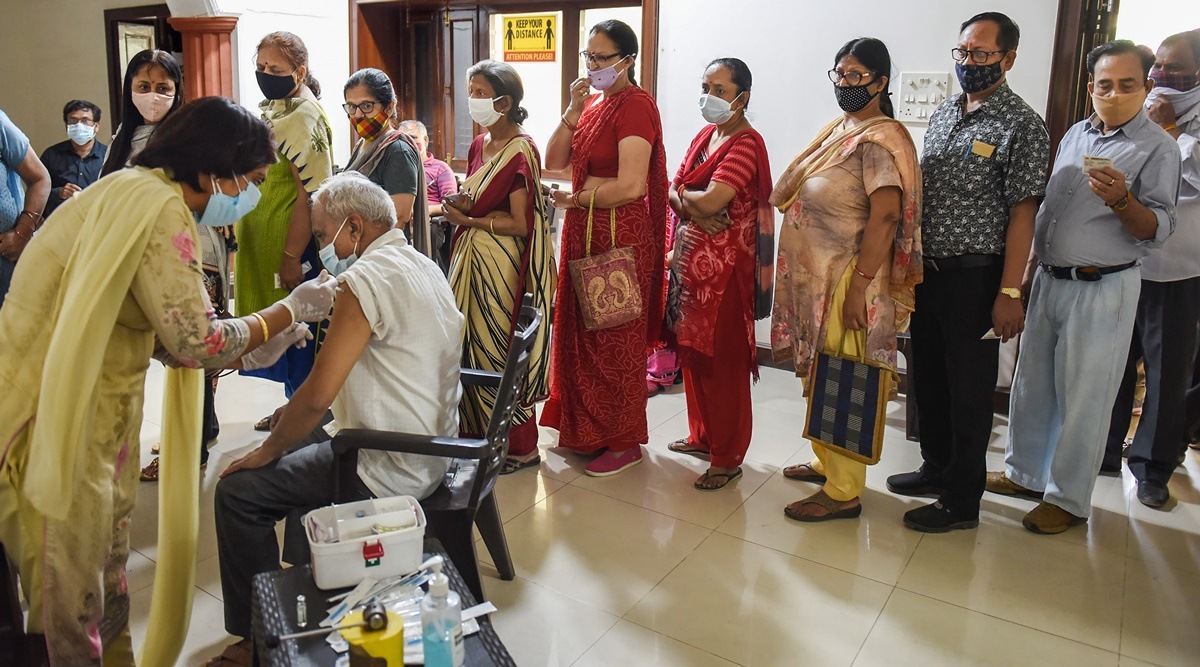 A medic administers a Covid-19 vaccine to a man during in Gurgaon. (PTI)
A medic administers a Covid-19 vaccine to a man during in Gurgaon. (PTI) Economists like market-based solutions due to their purported efficiency. The market relies on price mechanism and the forces of supply and demand. The market makes available any good to a buyer who values it the most. At the same time, increased competition drives up supply and pushes down prices, so that only the lowest cost producers are able to operate in the market. This combination leads to an efficient allocation of scarce resources.
All this is, however, true only when there is no “externality” associated with the consumption of a particular good. Vaccines have a “positive externality”; it is a good whose consumption benefits not just the one who has it. A vaccinated person is not only relatively protected against the disease himself/herself, but also less likely to transmit it to others.
Usually, though, a person getting vaccinated takes into account only his/her own cost and benefit, while ignoring the fact that he/she lowers the chances of infecting others. It is the opposite of smoking, which has “negative externality”. Smokers know the harm they are causing to themselves, but are largely indifferent to the negative impact of their cigarette smoke on others. Since every individual ignores the full set of benefits/costs from consuming goods with positive/negative externalities, the market isn’t always the most efficient mechanism for allocation of such goods. We would end up with what economists call “under-provision” or “over-provision” (too little or too much) of the good and a situation of “market failure”.
That is a key reason why governments treat goods having large positive externalities as “public goods” and provide these while factoring in the full costs and benefits to society. Viewed from this perspective, the latest version of India’s vaccine policy is quite significant. It requires vaccine manufacturers to supply 50 per cent of their production to the Centre at controlled prices, while allowing them to sell the remaining half in the open market (including to state governments) at pre-announced “self-set” prices.
Standard economic theory suggests that the above policy is susceptible to market failure. One could counter by saying that vaccine delivery by the private sector will be faster than the government. The country would, therefore, be better-off even with some under-provision. But this argument misses an essential point. To start with, the new policy can lead to differential access to the vaccine. Manufacturers are supposed to “transparently declare” their prices in advance for their 50 per cent supply to the open market. But there is no limit per se on the retail price they would charge. This could lead to a whole range of prices and vaccine inequality, apart from diversion of supplies from the controlled low-price government centres to the open market. So, we may well have scarcity in the “mass” segment co-existing with a glut in the “elite” segment.
However, our point isn’t about inequality alone. It is also about economic efficiency and the potential for market failure. Imagine there are two sets of people in India. The first consists of those who are better off and can afford to stay back or work from home. This lot is also less likely to cause infection to others. The second set is mostly blue-collar workers, small traders, vendors and agriculturists. The nature of their work — on the shop floor or in the field — makes them naturally prone to infect others. It follows, then, that society gains from first vaccinating the latter, as they have a higher negative externality.
The irony is that the section more prone to infecting others would also be low-income people, who cannot ordinarily afford the vaccine. Under these circumstances, when the market is allowed to deliver vaccines, those with higher incomes — and even prepared to pay more than what the manufacturers are currently charging — will have better access. The market will ignore those with lower purchasing power, despite them having a higher probability of spreading the disease. In fact, the bigger the income difference between the two segments, the greater will be the extent of market failure from simultaneous over-provisioning and under-provisioning.
Note this isn’t an argument on the ethics of vaccine inequality, but about the possible efficiency loss from the new policy. What can be an efficient solution that addresses market failure? Well, it could be a single price to be paid to vaccine makers for all the doses that they supply. The price should be high enough to stimulate them to rapidly ramp up production. But how can those without sufficient means pay this price? The answer is that they needn’t at all. The moment they receive a jab, it is the government that will pay the vaccine maker or the hospital administering the dose.
The suggested solution is similar to the fertiliser subsidy, which is now disbursed to companies only after actual sales to farmers. No subsidy is paid on any bag unless the purchase, along with the farmer’s biometric authentication and other details, is captured on a point-of-sale machine at the retail outlet linked to a central server. A similar mechanism, where the vaccine producer gets the full market price — it shouldn’t matter to him whether the final consumer or government pays — after a person gets the jab, will also ensure no diversion or grey market.
Ultimately, it is in our own interest to get not just ourselves, but also others, vaccinated.
Sarangi is department head and professor of economics at Virginia Polytechnic Institute and State University. Damodaran is national rural affairs & agriculture editor at The Indian Express and on sabbatical as senior fellow with the Centre for Policy Research
- The Indian Express website has been rated GREEN for its credibility and trustworthiness by Newsguard, a global service that rates news sources for their journalistic standards.

